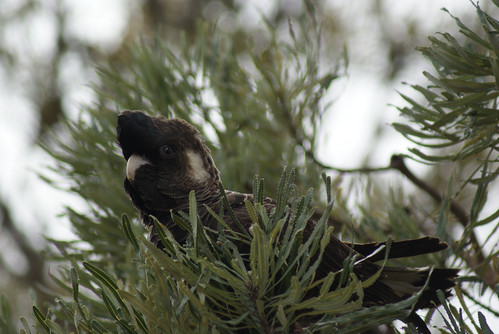 “Their foraging time gets reduced because they can only forage early in the morning or late in the afternoon.” —Dr Saunders. Image by Delia AnthonyNEW research shows the endangered species Carnaby’s Black Cockatoo (Calyptorhynchus latirostris) has been decimated by stochastic events in 2009 and 2010.
“Their foraging time gets reduced because they can only forage early in the morning or late in the afternoon.” —Dr Saunders. Image by Delia AnthonyNEW research shows the endangered species Carnaby’s Black Cockatoo (Calyptorhynchus latirostris) has been decimated by stochastic events in 2009 and 2010.
An article recently published by animal ecologist and former CSIRO research scientist Dr Dennis Saunders, animal ecologist Dr Peter Mawson, and DEC wildlife policing officer Rick Dawson cites hail storms, extreme hot weather, a probable disease outbreak and motor vehicle collisions as causes of death.
Dr Saunders says the severe thunderstorm of March 2010, in which giant hail stones damaged many cars, also had a devastating effect on Carnaby’s Black Cockatoos.
“We know that 81 were affected by the hail – 57 were killed and 24 were so badly injured with soft tissue and skeletal damage they would have to go into rehab,” he says.
He says these birds were nearly all found around Kings Park and Subiaco, where the heart of the storm was, but there was no way of knowing how many other birds the storm actually killed.
Dr Saunders says extreme hot weather also has taken its toll.
“Their foraging time gets reduced because they can only forage early in the morning or late in the afternoon,” he says.
In January 2010 many dead birds, including 145 dead Carnaby’s Black Cockatoos, were found dead near Hopetoun after a heat wave.
“The problem is that while they were shaded from the sun they were exposed to hot winds of over 50c,” Dr Saunders says.
“The only way they can cool down at that stage is to spread their feathers and try and shed heat—but what affectively happens is that they cook.”
He says an unknown disease probably caused Carnaby’s Black Cockatoos to die at Koobabbie, a property near Coorow, late in 2009.
“The birds had been dead too long for any post mortem,” Dr Saunders says.
The report says as many as 23 female Carnaby’s Black Cockatoos may have died at Koobabbie, which normally supported up to 30 nesting pairs and produced as many as 19 fledglings per year.
Dr Saunders says deaths from motor vehicle collisions are also increasing, partly because remnant vegetation along road sides includes low bushes on which cockatoos feed.
“The birds tend to fly out into clear areas to get airborne,” he says.
“There were 13 birds injured during that hail storm that were successfully rehabilitated and released, and two of those died within four months in collisions with cars.”